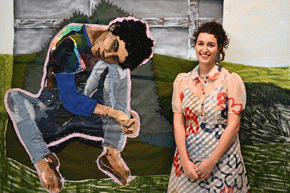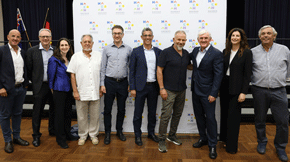Mozart is a Manny splendoured thing: a music review by Fraser Beath McEwing
If you want to put bums on seats you schedule all-Mozart programs. And if you want to add a bit of high-wire thrill you bring in Emanuel Ax to play two piano concertos per concert. That’s what spawned sell-out houses to the SSO’s opening series for 2018.

Emanuel Ax, David Robertson and the SSO
Photo: Daniela Testa
I went to the APT Master Series concert in which the avuncular Manny tossed off Mozart piano concertos No16 and No17, bookended by the Cosi fan tutte Overture and Symphony No 39. Not only that, but this remarkable pianist had packed four other Mozart piano concerts into the early February series, two per concert. I couldn’t help wondering if he ever has a moment of doubt as to what comes next when he’s in he middle of one of the six. But Manny’s been there before. He regularly pulls off this kind of feat overseas. He did something similar in Australia a couple of years ago with all five Beethoven piano concertos.
A good memory is only part of the challenge, of course. Mozart is the father of the piano concerto – he wrote 27 of them – conceived in the classical period but straining to reach into the romantic. In fact, popular musicologist, David Garrett, told his pre-concert talk audience that Mozart wrote the best piano concertos ever. I’m not so sure about that, but while his piano concertos are lighter in weight compared to those that came after, they take far more technical accomplishment and interpretation than might be apparent. They expose both pianist and orchestra to the elements where there is no smoke, mirrors or cacophony for cover.
However, let’s begin at the beginning with, appropriately, an overture to a Mozart opera, in this case, Cosi fan tutte. Although only a five-minute cobweb remover, it was pure Mozart, with vigour, playfulness and a few statements of grandeur. David Robertson conducted it from the south side of the grand piano, which had been placed in its solo position before the concert began.
Maybe it was to please Mozart’s spirit, but the orchestra had changed its usual layout. The six bull fiddles were on the left and so were the cellos, placing the rest of the chin-rest strings on either wing,
The overture done, Ax and Robertson strode out and we were set for the first of the piano concertos, but not before the audience had greeted Manny with palpable warmth. The orchestra had been slimmed down for these two works, losing two of is bull fiddles along with some other forces. They returned later for the symphony. The lighter concerto weight suited the music because it gave the piano a commanding voice when needed.
The first, No 16 in D, K451, began for all the world like a symphony with grand timpani backed statements and quite a lot of development before he piano entered with an attention seeking broken chord. It then joined the orchestra in collaboration rather than confrontation and immediately we began to fall under Ax’s Mozartian spell as he injected colour into the concerto without ever approaching schmaltz. In both concertos he demonstrated the beauty of the soft landing trill, the clarity of melody, legato at its best and that rare ability to play a whispering pianissimo that can be heard in the back row.
The andante movement came across as both playful and wistful, but he got down to serious technical business in the two cadenzas that call for rapid, single-note playing. He made it sound easy – which it certainly is not.
Ax and Robertson ripped into final rondeau movement at warp speed, which, while exciting, had me a little apprehensive in case it all flew to pieces. But it didn’t, and they got a rousing response from the audience.
The team returned after interval for the second piano concerto, No. 17 in G, K453.
Again it presented a symphonic opening, but then blossomed into a more decorated and busy work than the previous one, making additional technical demands on the pianist – again in rapid fire single notes.
To me, the highlight of the entire concert was the second movement of this concerto, marked andante. It was simply enchanting, and I never wanted it to end. Although the pianist led the magic, both conductor and orchestra were an indispensable part of it.
The third and final movement, marked allegretto presto, took the presto more seriously than other performances I’ve heard. That led to a sparkling conclusion but when it was done, it left me still thinking about the previous movement.
The final offering for the concert was Mozart’s Symphony No. 39 in E flat, K543.
David Robertson – and no doubt the orchestra too – were in jovial mood, which turned this popular symphony towards exuberance. They certainly didn’t trivialise it, but judging by the dance moves on the podium, they were all having one hell of a good time. That’s an endearing quality of David Robertson. While he’s passionate about the music he loves a bit of fun too.
Fraser Beath McEwing is an accomplished pianist and commentator on classical music performance and is a founding member of The theme & Variations Foundation Advisory Board which provides assistance to talented young Australian pianists. His professional background is in journalism, editing and publishing. He is also the author of three novels. and a Governor of the Sir Moses Montefiore Home.








